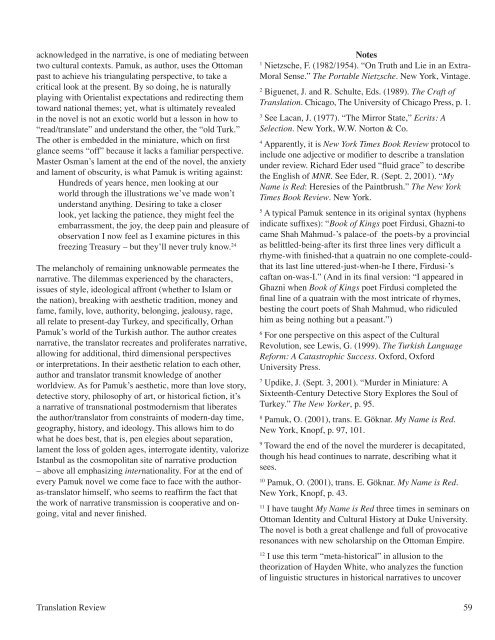Translation Review - The University of Texas at Dallas
Translation Review - The University of Texas at Dallas
Translation Review - The University of Texas at Dallas
Create successful ePaper yourself
Turn your PDF publications into a flip-book with our unique Google optimized e-Paper software.
acknowledged in the narr<strong>at</strong>ive, is one <strong>of</strong> medi<strong>at</strong>ing between<br />
two cultural contexts. Pamuk, as author, uses the Ottoman<br />
past to achieve his triangul<strong>at</strong>ing perspective, to take a<br />
critical look <strong>at</strong> the present. By so doing, he is n<strong>at</strong>urally<br />
playing with Orientalist expect<strong>at</strong>ions and redirecting them<br />
toward n<strong>at</strong>ional themes; yet, wh<strong>at</strong> is ultim<strong>at</strong>ely revealed<br />
in the novel is not an exotic world but a lesson in how to<br />
“read/transl<strong>at</strong>e” and understand the other, the “old Turk.”<br />
<strong>The</strong> other is embedded in the mini<strong>at</strong>ure, which on fi rst<br />
glance seems “<strong>of</strong>f” because it lacks a familiar perspective.<br />
Master Osmanʼs lament <strong>at</strong> the end <strong>of</strong> the novel, the anxiety<br />
and lament <strong>of</strong> obscurity, is wh<strong>at</strong> Pamuk is writing against:<br />
Hundreds <strong>of</strong> years hence, men looking <strong>at</strong> our<br />
world through the illustr<strong>at</strong>ions weʼve made wonʼt<br />
understand anything. Desiring to take a closer<br />
look, yet lacking the p<strong>at</strong>ience, they might feel the<br />
embarrassment, the joy, the deep pain and pleasure <strong>of</strong><br />
observ<strong>at</strong>ion I now feel as I examine pictures in this<br />
freezing Treasury – but theyʼll never truly know. 24<br />
<strong>The</strong> melancholy <strong>of</strong> remaining unknowable perme<strong>at</strong>es the<br />
narr<strong>at</strong>ive. <strong>The</strong> dilemmas experienced by the characters,<br />
issues <strong>of</strong> style, ideological affront (whether to Islam or<br />
the n<strong>at</strong>ion), breaking with aesthetic tradition, money and<br />
fame, family, love, authority, belonging, jealousy, rage,<br />
all rel<strong>at</strong>e to present-day Turkey, and specifi cally, Orhan<br />
Pamukʼs world <strong>of</strong> the Turkish author. <strong>The</strong> author cre<strong>at</strong>es<br />
narr<strong>at</strong>ive, the transl<strong>at</strong>or recre<strong>at</strong>es and prolifer<strong>at</strong>es narr<strong>at</strong>ive,<br />
allowing for additional, third dimensional perspectives<br />
or interpret<strong>at</strong>ions. In their aesthetic rel<strong>at</strong>ion to each other,<br />
author and transl<strong>at</strong>or transmit knowledge <strong>of</strong> another<br />
worldview. As for Pamukʼs aesthetic, more than love story,<br />
detective story, philosophy <strong>of</strong> art, or historical fi ction, itʼs<br />
a narr<strong>at</strong>ive <strong>of</strong> transn<strong>at</strong>ional postmodernism th<strong>at</strong> liber<strong>at</strong>es<br />
the author/transl<strong>at</strong>or from constraints <strong>of</strong> modern-day time,<br />
geography, history, and ideology. This allows him to do<br />
wh<strong>at</strong> he does best, th<strong>at</strong> is, pen elegies about separ<strong>at</strong>ion,<br />
lament the loss <strong>of</strong> golden ages, interrog<strong>at</strong>e identity, valorize<br />
Istanbul as the cosmopolitan site <strong>of</strong> narr<strong>at</strong>ive production<br />
– above all emphasizing intern<strong>at</strong>ionality. For <strong>at</strong> the end <strong>of</strong><br />
every Pamuk novel we come face to face with the authoras-transl<strong>at</strong>or<br />
himself, who seems to reaffi rm the fact th<strong>at</strong><br />
the work <strong>of</strong> narr<strong>at</strong>ive transmission is cooper<strong>at</strong>ive and ongoing,<br />
vital and never fi nished.<br />
Notes<br />
1 Nietzsche, F. (1982/1954). “On Truth and Lie in an Extra-<br />
Moral Sense.” <strong>The</strong> Portable Nietzsche. New York, Vintage.<br />
2 Biguenet, J. and R. Schulte, Eds. (1989). <strong>The</strong> Craft <strong>of</strong><br />
<strong>Transl<strong>at</strong>ion</strong>. Chicago, <strong>The</strong> <strong>University</strong> <strong>of</strong> Chicago Press, p. 1.<br />
3 See Lacan, J. (1977). “<strong>The</strong> Mirror St<strong>at</strong>e,” Ecrits: A<br />
Selection. New York, W.W. Norton & Co.<br />
4 Apparently, it is New York Times Book <strong>Review</strong> protocol to<br />
include one adjective or modifi er to describe a transl<strong>at</strong>ion<br />
under review. Richard Eder used “fl uid grace” to describe<br />
the English <strong>of</strong> MNR. See Eder, R. (Sept. 2, 2001). “My<br />
Name is Red: Heresies <strong>of</strong> the Paintbrush.” <strong>The</strong> New York<br />
Times Book <strong>Review</strong>. New York.<br />
5 A typical Pamuk sentence in its original syntax (hyphens<br />
indic<strong>at</strong>e suffi xes): “Book <strong>of</strong> Kings poet Firdusi, Ghazni-to<br />
came Shah Mahmud-ʼs palace-<strong>of</strong> the poets-by a provincial<br />
as belittled-being-after its fi rst three lines very diffi cult a<br />
rhyme-with fi nished-th<strong>at</strong> a qu<strong>at</strong>rain no one complete-couldth<strong>at</strong><br />
its last line uttered-just-when-he I there, Firdusi-ʼs<br />
caftan on-was-I.” (And in its fi nal version: “I appeared in<br />
Ghazni when Book <strong>of</strong> Kings poet Firdusi completed the<br />
fi nal line <strong>of</strong> a qu<strong>at</strong>rain with the most intric<strong>at</strong>e <strong>of</strong> rhymes,<br />
besting the court poets <strong>of</strong> Shah Mahmud, who ridiculed<br />
him as being nothing but a peasant.”)<br />
6 For one perspective on this aspect <strong>of</strong> the Cultural<br />
Revolution, see Lewis, G. (1999). <strong>The</strong> Turkish Language<br />
Reform: A C<strong>at</strong>astrophic Success. Oxford, Oxford<br />
<strong>University</strong> Press.<br />
7 Updike, J. (Sept. 3, 2001). “Murder in Mini<strong>at</strong>ure: A<br />
Sixteenth-Century Detective Story Explores the Soul <strong>of</strong><br />
Turkey.” <strong>The</strong> New Yorker, p. 95.<br />
8 Pamuk, O. (2001), trans. E. Göknar. My Name is Red.<br />
New York, Knopf, p. 97, 101.<br />
9 Toward the end <strong>of</strong> the novel the murderer is decapit<strong>at</strong>ed,<br />
though his head continues to narr<strong>at</strong>e, describing wh<strong>at</strong> it<br />
sees.<br />
10 Pamuk, O. (2001), trans. E. Göknar. My Name is Red.<br />
New York, Knopf, p. 43.<br />
11 I have taught My Name is Red three times in seminars on<br />
Ottoman Identity and Cultural History <strong>at</strong> Duke <strong>University</strong>.<br />
<strong>The</strong> novel is both a gre<strong>at</strong> challenge and full <strong>of</strong> provoc<strong>at</strong>ive<br />
resonances with new scholarship on the Ottoman Empire.<br />
12 I use this term “meta-historical” in allusion to the<br />
theoriz<strong>at</strong>ion <strong>of</strong> Hayden White, who analyzes the function<br />
<strong>of</strong> linguistic structures in historical narr<strong>at</strong>ives to uncover<br />
<strong>Transl<strong>at</strong>ion</strong> <strong>Review</strong> 59

















